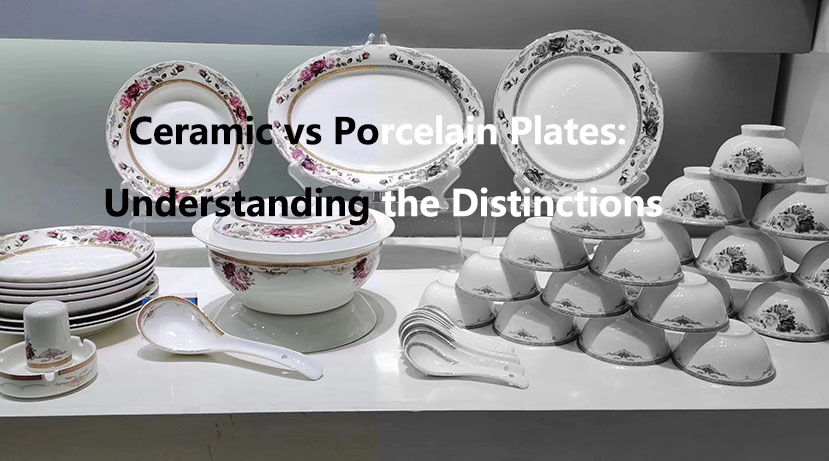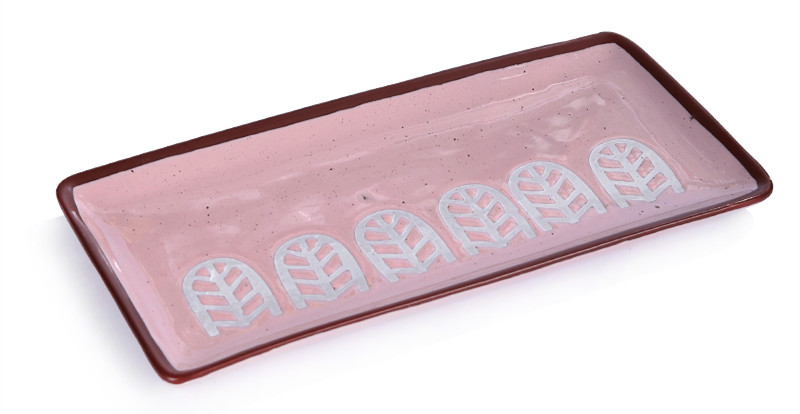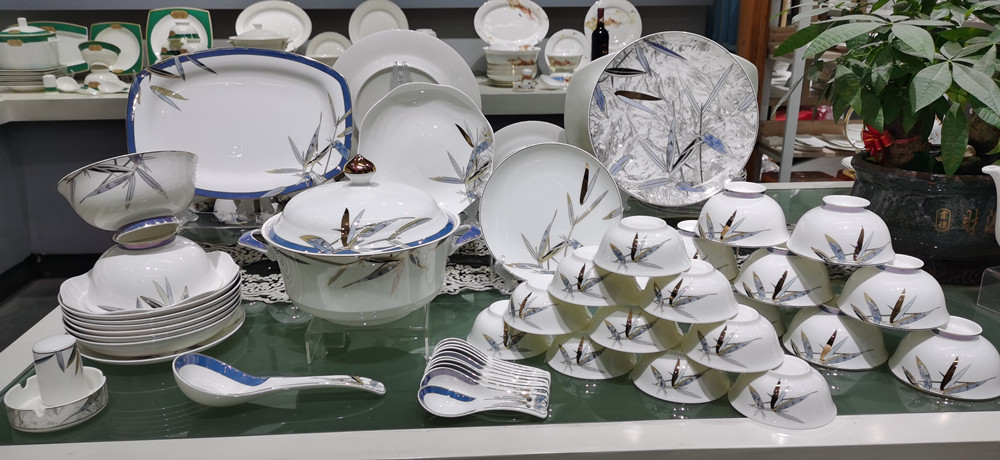Ceramic vs Porcelain Plates: Understanding the Distinctions
Time of issue: 2024-02-05 11:23:52
When it comes to dining and tableware, the choice between ceramic and porcelain plates can be perplexing. While both materials are popular for their aesthetic appeal and functionality, they possess unique characteristics that set them apart. In this comprehensive guide, we'll explore the differences between ceramic and porcelain plates, helping you make an informed decision for your table setting needs.
Introduction
In the world of tableware, ceramics have been cherished for centuries for their practicality and elegance. Porcelain, a subtype of ceramic, is often regarded as the epitome of fine dining. However, the distinction between the two is more nuanced than meets the eye. To appreciate the differences, we must delve into the world of ceramics, their composition, production processes, and practical applications.
Depend on Wiki. A plate is a broad, mainly flat vessel on which food can be served. A plate can also be used for ceremonial or decorative purposes. Most plates are circular, but they may be any shape, or made of any water-resistant material.
Ceramic Plates

Composition
From University of Washington. Ceramics are generally made by taking mixtures of clay, earthen elements, powders, and water and shaping them into desired forms. Once the ceramic has been shaped. it is fired in a high temperature oven known as a kiln. Often, ceramics are covered in decorative, waterproof, paint-like substances known as glazes.
Ceramic plates are crafted from clay, which is a natural material abundant in the Earth's crust. This clay is formed into the desired plate shape and then fired at high temperatures to achieve its final form. The composition of ceramic plates may vary, but they typically include kaolin clay, ball clay, and other minerals. This combination results in a sturdy and versatile material, suitable for daily use.
Appearance
Ceramic plates exhibit a wide range of styles and designs, making them versatile for various table settings. They can be glazed or unglazed, and the finish can be glossy or matte. Ceramic plates often boast vibrant colors and patterns, making them a popular choice for casual and artistic tablescapes.
Durability
While ceramic plates are durable and can withstand regular use, they are more prone to chipping and cracking compared to porcelain. The firing process leaves them slightly more porous, making them less resistant to extreme temperatures and impacts. However, with proper care, ceramic plates can maintain their beauty and functionality for many years.
Practical Uses
Ceramic plates are well-suited for everyday dining and informal occasions. Their diverse styles make them a favorite for casual family meals, picnics, and outdoor gatherings. They are also ideal for serving pasta, salads, and appetizers.
Porcelain Plates

Composition
From Britannica. Porcelain, vitrified pottery with a white, fine-grained body that is usually translucent, as distinguished from earthenware, which is porous, opaque, and coarser. The distinction between porcelain and stoneware, the other class of vitrified pottery material, is less clear. In China, porcelain is defined as pottery that is resonant when struck. In the West, it is a material that is translucent when held to the light. Neither definition is totally satisfactory: some heavily potted porcelains are opaque, while some thinly potted stonewares are somewhat translucent. The word porcelain is derived from porcellana, used by Marco Polo to describe the pottery he saw in China.
Porcelain is a specific type of ceramic, known for its exceptional quality and elegance. It is composed of fine kaolin clay, which is known for its purity and translucence. This clay is fired at extremely high temperatures, resulting in a dense, glass-like material that is both strong and delicate.
Appearance
Porcelain plates are renowned for their exquisite appearance. They have a smooth, white, and glossy finish that imparts a sense of luxury to any table setting. The translucency of porcelain allows light to pass through, giving it a delicate and refined look.
Durability
Porcelain plates are exceptionally durable and resistant to chipping and cracking. Their density and low porosity make them highly resilient to both high and low temperatures. This makes them suitable for formal dining occasions where high-quality tableware is essential.
Practical Uses
Porcelain plates are the preferred choice for formal and special occasions. They are perfect for serving gourmet meals, fine dining, and hosting guests. Their elegant appearance elevates the dining experience, making them a staple in upscale restaurants and luxurious homes.
Key Differences
Now that we have explored the individual characteristics of ceramic and porcelain plates, let's highlight the key differences between the two:
1. Composition
Ceramic plates are made from various types of clay, resulting in a sturdier material.
Porcelain plates are made from fine kaolin clay, resulting in a more delicate and translucent material.
2. Appearance
Ceramic plates offer a wide range of designs, colors, and finishes.
Porcelain plates have a smooth, white, and glossy finish with a more refined appearance.
3. Durability
Ceramic plates are durable but are more prone to chipping and cracking.
Porcelain plates are highly durable and resistant to chipping and cracking.
4. Practical Uses
Ceramic plates are suitable for everyday dining and casual occasions.
Porcelain plates are ideal for formal and special occasions, enhancing the dining experience.
Making the Right Choice
Choosing between ceramic and porcelain plates ultimately depends on your preferences and intended use. Here are some factors to consider when making your decision:
Occasion: Consider whether you need tableware for everyday use or special occasions. Ceramic plates are versatile for casual settings, while porcelain plates add sophistication to formal events.
Aesthetic Preferences: Your personal style and the overall theme of your dining space can influence your choice. Ceramic plates offer more design options, while porcelain plates exude elegance.
Durability: If you prioritize durability and resistance to wear and tear, porcelain plates are the better choice. Ceramic plates are suitable for those willing to handle them with care.
Budget: Ceramic plates are generally more budget-friendly, making them a practical choice for families and those on a tight budget. Porcelain plates tend to be more expensive due to their premium quality.
Care and Maintenance
Regardless of your choice, proper care is essential to extend the lifespan of your plates. Here are some general tips for maintaining both ceramic and porcelain plates:
Avoid extreme temperature changes, such as placing hot plates in cold water or vice versa, as this can cause thermal shock and lead to cracks.
Handwashing with mild dish soap and warm water is recommended for both types of plates, as it helps preserve their finish and minimize the risk of chipping.
Use soft, non-abrasive sponges or dishcloths to clean your plates to prevent scratching.
Store your plates carefully, with sufficient padding or plate dividers, to prevent them from knocking against each other.
Be cautious when using metal utensils on your plates, as they can leave scratches.
Check for manufacturer-specific care instructions, as some ceramic and porcelain plates may have unique requirements.
Conclusion
In the realm of tableware, the choice between ceramic and porcelain plates ultimately boils down to your preferences and dining needs. Ceramic plates offer versatility, a range of styles, and budget-friendliness, making them suitable for everyday use. Porcelain plates, on the other hand, exude luxury, elegance, and exceptional durability, making them the perfect choice for special occasions and formal dining.
Understanding the distinctions between these two materials empowers you to make an informed decision that enhances your dining experience. Whether you opt for the practicality of ceramic or the refinement of porcelain, your choice of plates can elevate your meals and gatherings to a new level of sophistication and enjoyment.
RECENT POSTS
- The Benefits of Wholesale High-Quality Ceramic Products for Retailers
2025-12-17
- Can You Make an Ashtray with Air Dry Clay? Pros, Cons, and Safer Alternatives
2025-12-17
- The Impact of Ceramic Materials in Energy-Efficient Buildings: Benefits and Applications
2025-12-04
- Top 7 Ceramic Cookware Health Benefits: Why It’s a Safer Choice for Your Kitchen
2025-12-04
- How to Clean Ceramic Planters and Improve Their Lifespan?
2025-11-17
- 15 Best Ceramic Holiday Gift Ideas for 2025: Thoughtful, Elegant & Heartfelt
2025-11-17
- Stoneware vs Porcelain vs Earthenware: Quick Decision Guide
2025-10-09
- Are Ceramic Glazes Food Safe? The Truth Behind the Shine
2025-10-09










